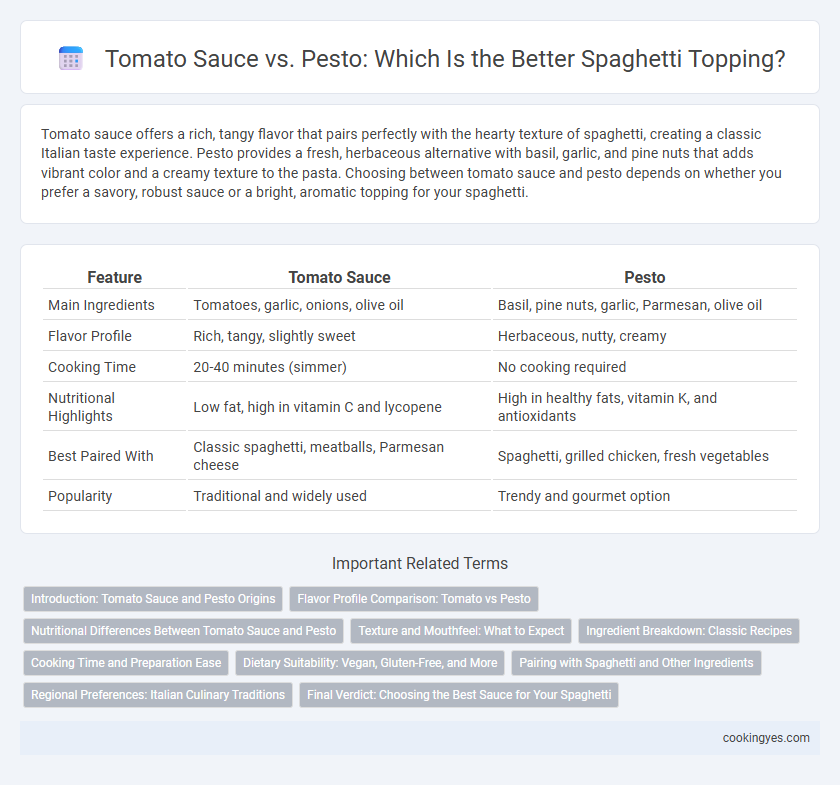Tomato sauce offers a rich, tangy flavor that pairs perfectly with the hearty texture of spaghetti, creating a classic Italian taste experience. Pesto provides a fresh, herbaceous alternative with basil, garlic, and pine nuts that adds vibrant color and a creamy texture to the pasta. Choosing between tomato sauce and pesto depends on whether you prefer a savory, robust sauce or a bright, aromatic topping for your spaghetti.
Table of Comparison
| Feature | Tomato Sauce | Pesto |
|---|---|---|
| Main Ingredients | Tomatoes, garlic, onions, olive oil | Basil, pine nuts, garlic, Parmesan, olive oil |
| Flavor Profile | Rich, tangy, slightly sweet | Herbaceous, nutty, creamy |
| Cooking Time | 20-40 minutes (simmer) | No cooking required |
| Nutritional Highlights | Low fat, high in vitamin C and lycopene | High in healthy fats, vitamin K, and antioxidants |
| Best Paired With | Classic spaghetti, meatballs, Parmesan cheese | Spaghetti, grilled chicken, fresh vegetables |
| Popularity | Traditional and widely used | Trendy and gourmet option |
Introduction: Tomato Sauce and Pesto Origins
Tomato sauce, originating from 16th-century Italy, became a staple in Mediterranean cuisine with its rich base of tomatoes, garlic, and herbs, perfect for enhancing spaghetti. Pesto, rooted in the Ligurian region of Italy, combines fresh basil, pine nuts, garlic, Parmesan cheese, and olive oil, offering a vibrant and aromatic alternative. Both sauces bring unique regional flavors that highlight Italy's culinary diversity and are essential for traditional spaghetti dishes.
Flavor Profile Comparison: Tomato vs Pesto
Tomato sauce offers a rich, tangy flavor with a hint of sweetness and acidity that complements the savory notes of spaghetti. Pesto, made from fresh basil, garlic, pine nuts, and Parmesan, provides a vibrant, herbaceous taste with creamy texture and nutty undertones. The choice between tomato sauce and pesto hinges on whether you prefer a bright, bold tomato base or a fragrant, slightly spicy herbal experience.
Nutritional Differences Between Tomato Sauce and Pesto
Tomato sauce offers a low-calorie, vitamin-rich option with high levels of vitamin C, potassium, and lycopene, a powerful antioxidant linked to reduced heart disease risk. Pesto, made from basil, pine nuts, garlic, Parmesan cheese, and olive oil, typically contains higher fat and calorie content but provides healthy monounsaturated fats, vitamin E, and protein. Choosing between tomato sauce and pesto depends on whether one prioritizes lower calories and antioxidants or nutrient-dense fats and additional protein for spaghetti toppings.
Texture and Mouthfeel: What to Expect
Tomato sauce offers a smooth, rich texture that coats spaghetti evenly, providing a warm, velvety mouthfeel with slight acidity and sweetness. Pesto delivers a chunkier, oilier texture from crushed pine nuts, basil, and olive oil, creating a fresh, slightly gritty bite with a herbaceous, nutty sensation. The choice between them impacts the overall sensory experience, with tomato sauce offering a comforting softness and pesto presenting a vibrant, textured contrast.
Ingredient Breakdown: Classic Recipes
Tomato sauce for spaghetti typically features ripe tomatoes, garlic, onions, olive oil, and fresh basil, creating a rich, tangy base with natural sweetness and acidity. Pesto consists primarily of fresh basil leaves, pine nuts, Parmesan cheese, garlic, and olive oil, offering a creamy texture and herbaceous, nutty flavor profile. Classic tomato sauce emphasizes slow-cooked depth with simmered ingredients, while traditional pesto relies on uncooked, vibrant components blended to preserve freshness.
Cooking Time and Preparation Ease
Tomato sauce typically requires 30 to 45 minutes of simmering to develop rich flavors, making it a longer cooking process compared to pesto. Pesto, made from fresh basil, garlic, pine nuts, Parmesan cheese, and olive oil, takes only about 5 to 10 minutes to prepare, offering a quick and easy topping for spaghetti. For those prioritizing cooking time and simplicity, pesto provides a fresh and vibrant alternative to the more time-intensive tomato sauce.
Dietary Suitability: Vegan, Gluten-Free, and More
Tomato sauce is naturally vegan and gluten-free, making it suitable for most dietary preferences, while pesto often contains cheese, which may not be vegan unless specifically prepared without dairy. Both sauces can be adapted for gluten-free diets, but tomato sauce is typically free from gluten-containing additives. Choosing between tomato sauce and pesto depends on dietary restrictions such as veganism, lactose intolerance, and allergen sensitivities.
Pairing with Spaghetti and Other Ingredients
Tomato sauce offers a classic pairing with spaghetti, enhancing the pasta's texture with its rich, tangy flavor and complementing ingredients like garlic, basil, and Parmesan cheese. Pesto provides a vibrant, herbaceous alternative made from basil, pine nuts, garlic, and olive oil, creating a lighter, fresher profile that pairs well with tomatoes, mozzarella, and roasted vegetables. Each sauce brings a distinct taste and texture to spaghetti, influencing the overall dish's balance and ingredient harmony.
Regional Preferences: Italian Culinary Traditions
Italian culinary traditions highlight distinct regional preferences for spaghetti toppings, with tomato sauce dominant in Southern Italy, particularly in regions like Campania where ripe San Marzano tomatoes thrive. In contrast, Northern Italy, especially Liguria, favors pesto made from fresh basil, pine nuts, garlic, Parmesan cheese, and olive oil, reflecting local agricultural products and flavors. These regional sauces showcase Italy's diverse gastronomic heritage and the cultural importance of linking ingredients to their place of origin.
Final Verdict: Choosing the Best Sauce for Your Spaghetti
Tomato sauce offers a classic, rich flavor profile that pairs well with traditional spaghetti varieties, providing a balance of acidity, sweetness, and herbs like basil and oregano. Pesto, made from basil, pine nuts, Parmesan, garlic, and olive oil, delivers a fresh, vibrant, and herbaceous taste, ideal for those seeking a lighter, more aromatic option. The best sauce for your spaghetti ultimately depends on whether you prefer a hearty, comforting meal with tomato sauce or a bright, flavorful experience with pesto.
Tomato Sauce vs Pesto for Spaghetti Topping Infographic

 cookingyes.com
cookingyes.com